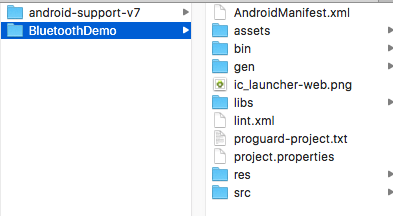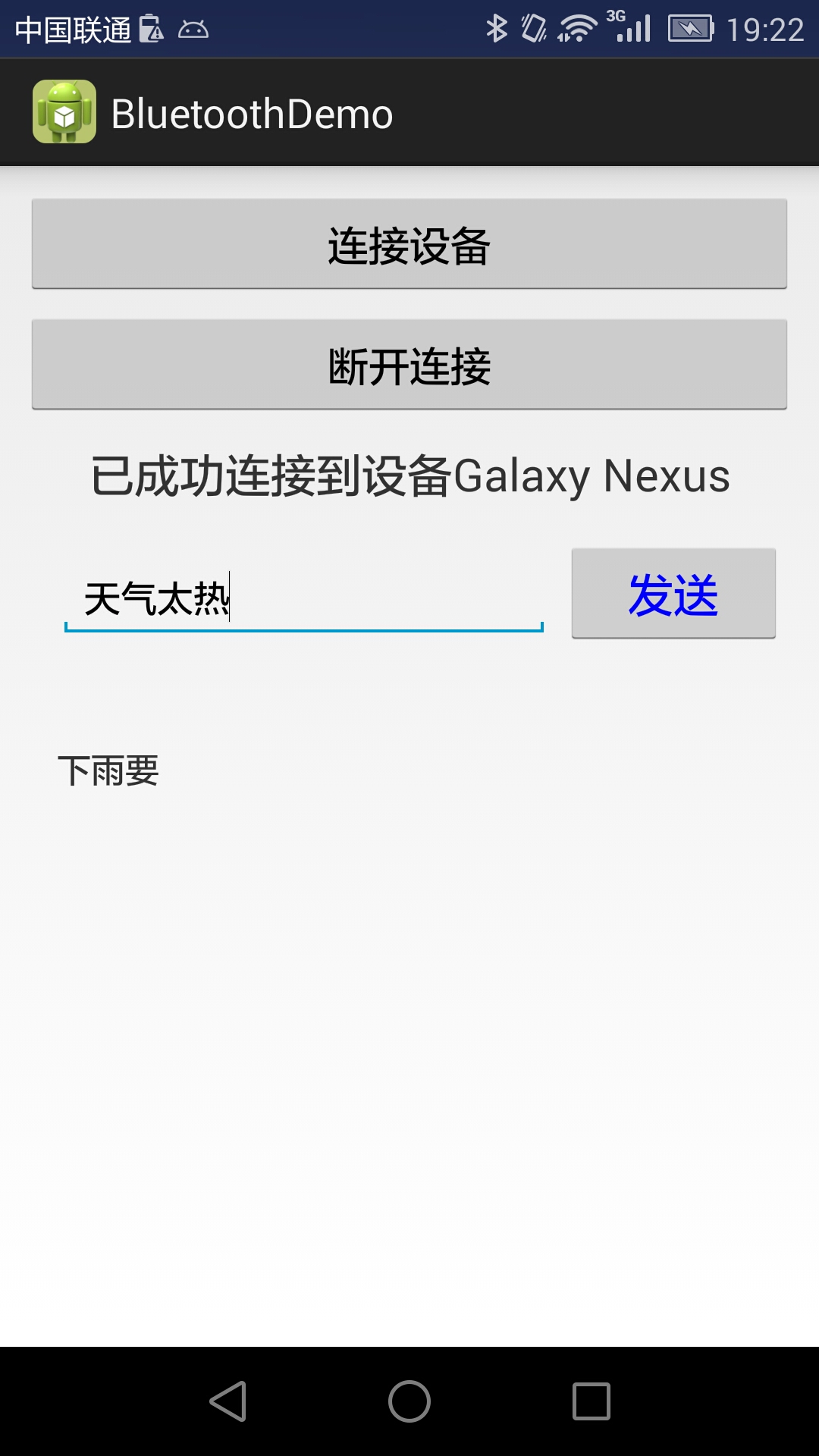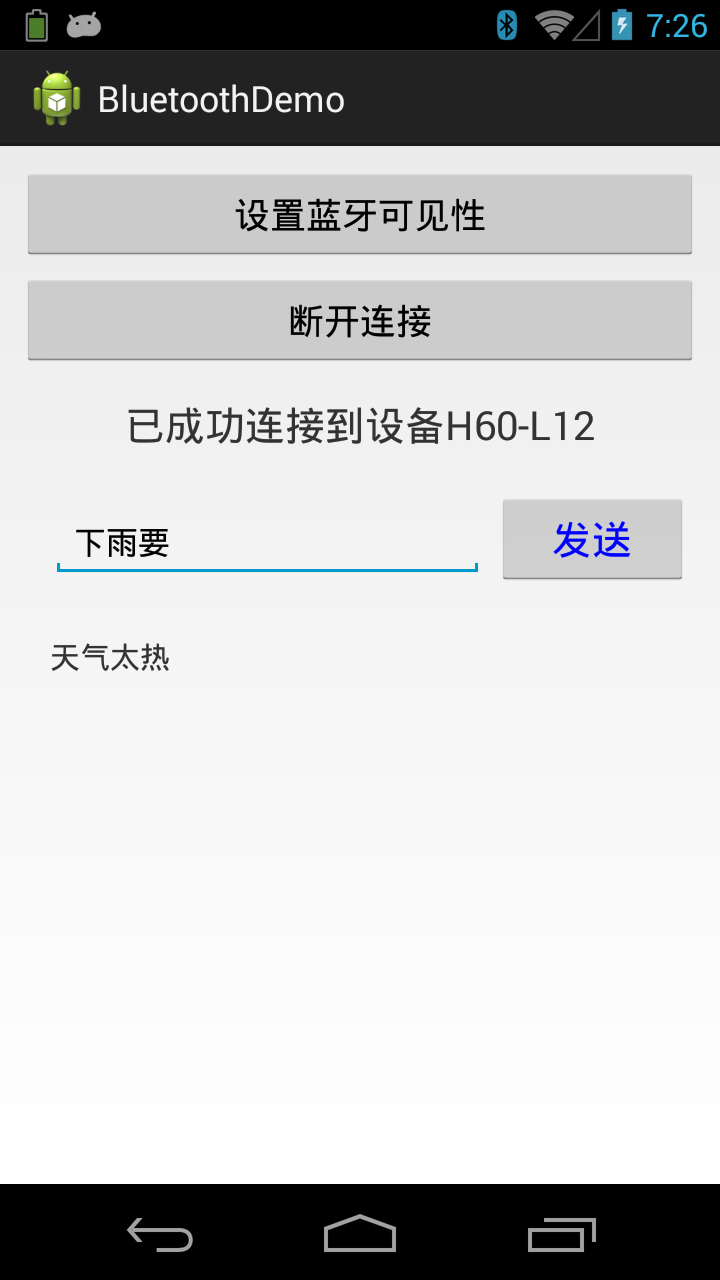Android -传统蓝牙通信聊天
概述
详细
原文地址:
Android 蓝牙开发(一)蓝牙通信 CSDN
一、准备工作
开发环境:
jdk1.8
Eclipse Luna Service Release 1 (4.4.1)
运行环境:
华为荣耀6(Android4.4)、华为p9(Android7.0)
实现功能:
-
Android 蓝牙开发 (开关蓝牙、搜索设备、蓝牙配对、连接、通信、断开连接等)。
二、代码结构
代码包里面,有两个部分,一个是源码,一个是V7支持包。

三、程序实现-蓝牙通信
1 蓝牙基本操作
随着可穿戴设备的流行,研究蓝牙是必不可少的一门技术了。
总结了下蓝牙开发使用的一些东西分享一下。
蓝牙权限
首先需要AndroidManifest.xml文件中添加操作蓝牙的权限。
1 2 3 4 | <uses-permissionandroid:name="Android.permission.BLUETOOTH" />//允许程序连接到已配对的蓝牙设备。<uses-permissionandroid:name="android.permission.BLUETOOTH_ADMIN" />//允许程序发现和配对蓝牙设备。 |
BluetoothAdapter
操作蓝牙主要用到的类 BluetoothAdapter类,使用时导包
import android.bluetooth.BluetoothAdapter;
源码具体位置frameworks/base/core/Java/android/bluetooth/BluetoothAdapter.java
BluetoothAdapter 代表本地设备的蓝牙适配器。该BluetoothAdapter可以执行基本的蓝牙任务,例如启
动设备发现,查询配对的设备列表,使用已知的MAC地址实例化一个BluetoothDevice类,并创建一个
BluetoothServerSocket监听来自其他设备的连接请求。
获取蓝牙适配器
1 | BluetoothAdapter mBluetoothAdapter = BluetoothAdapter.getDefaultAdapter(); |
开启蓝牙
1 2 3 4 5 6 7 | if(!mBluetoothAdapter.isEnabled()){ //弹出对话框提示用户是后打开 Intent enabler = new Intent(BluetoothAdapter.ACTION_REQUEST_ENABLE); startActivityForResult(enabler, REQUEST_ENABLE); //不做提示,直接打开,不建议用下面的方法,有的手机会有问题。 // mBluetoothAdapter.enable(); } |
获取本地蓝牙信息
1 2 3 4 5 6 7 8 9 10 11 | //获取本机蓝牙名称 String name = mBluetoothAdapter.getName(); //获取本机蓝牙地址 String address = mBluetoothAdapter.getAddress(); Log.d(TAG,"bluetooth name ="+name+" address ="+address); //获取已配对蓝牙设备 Set<BluetoothDevice> devices = mBluetoothAdapter.getBondedDevices(); Log.d(TAG, "bonded device size ="+devices.size()); for(BluetoothDevice bonddevice:devices){ Log.d(TAG, "bonded device name ="+bonddevice.getName()+" address"+bonddevice.getAddress()); } |
搜索设备
1 | mBluetoothAdapter.startDiscovery(); |
停止搜索
1 | mBluetoothAdapter.cancelDiscovery(); |
搜索蓝牙设备,该过程是异步的,通过下面注册广播接受者,可以监听是否搜到设备。
1 2 3 4 5 6 7 8 | IntentFilter filter = new IntentFilter(); //发现设备 filter.addAction(BluetoothDevice.ACTION_FOUND); //设备连接状态改变 filter.addAction(BluetoothDevice.ACTION_BOND_STATE_CHANGED); //蓝牙设备状态改变 filter.addAction(BluetoothAdapter.ACTION_STATE_CHANGED); registerReceiver(mBluetoothReceiver, filter); |
监听扫描结果
通过广播接收者查看扫描到的蓝牙设备,每扫描到一个设备,系统都会发送此广播(BluetoothDevice.ACTION_FOUNDE)。其中参数intent可以获取蓝牙设备BluetoothDevice。
该demo中是连接指定名称的蓝牙设备,BLUETOOTH_NAME为"Galaxy Nexus",如果扫描不到,记得改这个蓝牙名称。
1 2 3 4 5 6 7 8 9 10 11 12 13 14 15 16 17 18 19 20 21 22 23 | private BroadcastReceiver mBluetoothReceiver = new BroadcastReceiver(){ @Override public void onReceive(Context context, Intent intent) { String action = intent.getAction(); Log.d(TAG,"mBluetoothReceiver action ="+action); if(BluetoothDevice.ACTION_FOUND.equals(action)){//每扫描到一个设备,系统都会发送此广播。 //获取蓝牙设备 BluetoothDevice scanDevice = intent.getParcelableExtra(BluetoothDevice.EXTRA_DEVICE); if(scanDevice == null || scanDevice.getName() == null) return; Log.d(TAG, "name="+scanDevice.getName()+"address="+scanDevice.getAddress()); //蓝牙设备名称 String name = scanDevice.getName(); if(name != null && name.equals(BLUETOOTH_NAME)){ mBluetoothAdapter.cancelDiscovery(); //取消扫描 mProgressDialog.setTitle(getResources().getString(R.string.progress_connecting)); //连接到设备。 mBlthChatUtil.connect(scanDevice); } }else if (BluetoothAdapter.ACTION_DISCOVERY_FINISHED.equals(action)){ } } }; |
设置蓝牙可见性
有时候扫描不到某设备,这是因为该设备对外不可见或者距离远,需要设备该蓝牙可见,这样该才能被搜索到。
可见时间默认值为120s,最多可设置300。
1 2 3 4 5 6 7 8 9 10 | if (mBluetoothAdapter.isEnabled()) { if (mBluetoothAdapter.getScanMode() != BluetoothAdapter.SCAN_MODE_CONNECTABLE_DISCOVERABLE) { Intent discoverableIntent = new Intent( BluetoothAdapter.ACTION_REQUEST_DISCOVERABLE); discoverableIntent.putExtra( BluetoothAdapter.EXTRA_DISCOVERABLE_DURATION, 120); startActivity(discoverableIntent); } } |
2 服务端
android 蓝牙之间可以通过SDP协议建立连接进行通信,通信方式类似于平常使用socket。
首先创建BluetoothServerSocket ,BluetoothAdapter中提供了两种创建BluetoothServerSocket 方式,如下图所示为创建安全的RFCOMM Bluetooth socket,该连接是安全的需要进行配对。而通过listenUsingInsecureRfcommWithServiceRecord创建的RFCOMM Bluetooth socket是不安全的,连接时不需要进行配对。
其中的uuid需要服务器端和客户端进行统一。
1 2 3 4 5 6 7 8 9 10 11 12 13 14 15 16 17 18 19 20 21 22 23 24 25 26 27 28 29 30 31 32 33 34 35 36 37 38 39 40 41 42 43 44 45 46 47 48 49 50 51 52 53 54 55 56 57 58 59 60 61 62 | private class AcceptThread extends Thread { // 本地服务器套接字 private final BluetoothServerSocket mServerSocket; public AcceptThread() { BluetoothServerSocket tmp = null; // 创建一个新的侦听服务器套接字 try { tmp = mAdapter.listenUsingRfcommWithServiceRecord( SERVICE_NAME, SERVICE_UUID); //tmp = mAdapter.listenUsingInsecureRfcommWithServiceRecord(SERVICE_NAME, SERVICE_UUID); } catch (IOException e) { Log.e(TAG, "listen() failed", e); } mServerSocket = tmp; } public void run() { BluetoothSocket socket = null; // 循环,直到连接成功 while (mState != STATE_CONNECTED) { try { // 这是一个阻塞调用 返回成功的连接 // mServerSocket.close()在另一个线程中调用,可以中止该阻塞 socket = mServerSocket.accept(); } catch (IOException e) { Log.e(TAG, "accept() failed", e); break; } // 如果连接被接受 if (socket != null) { synchronized (BluetoothChatUtil.this) { switch (mState) { case STATE_LISTEN: case STATE_CONNECTING: // 正常情况。启动ConnectedThread。 connected(socket, socket.getRemoteDevice()); break; case STATE_NONE: case STATE_CONNECTED: // 没有准备或已连接。新连接终止。 try { socket.close(); } catch (IOException e) { Log.e(TAG, "Could not close unwanted socket", e); } break; } } } } if (D) Log.i(TAG, "END mAcceptThread"); } public void cancel() { if (D) Log.d(TAG, "cancel " + this); try { mServerSocket.close(); } catch (IOException e) { Log.e(TAG, "close() of server failed", e); } } } |
mServerSocket通过accept()等待客户端的连接(阻塞),直到连接成功或失败。
3 客户端
客户端主要用来创建RFCOMM socket,并连接服务端。
先扫描周围的蓝牙设备,如果扫描到指定设备则进行连接。mBlthChatUtil.connect(scanDevice)连接到设备,
连接过程主要在ConnectThread线程中进行,先创建socket,方式有两种,
如下代码中是安全的(createRfcommSocketToServiceRecord)。另一种不安全连接对应的函数是createInsecureRfcommSocketToServiceRecord。
1 2 3 4 5 6 7 8 9 10 11 12 13 14 15 16 17 18 19 20 21 22 23 24 25 26 27 28 29 30 31 32 33 34 35 36 37 38 39 40 41 42 | private class ConnectThread extends Thread { private BluetoothSocket mmSocket; private final BluetoothDevice mmDevice; public ConnectThread(BluetoothDevice device) { mmDevice = device; BluetoothSocket tmp = null; // 得到一个bluetoothsocket try { mmSocket = device.createRfcommSocketToServiceRecord (SERVICE_UUID); } catch (IOException e) { Log.e(TAG, "create() failed", e); mmSocket = null; } } public void run() { Log.i(TAG, "BEGIN mConnectThread"); try { // socket 连接,该调用会阻塞,直到连接成功或失败 mmSocket.connect(); } catch (IOException e) { connectionFailed(); try {//关闭这个socket mmSocket.close(); } catch (IOException e2) { e2.printStackTrace(); } return; } // 启动连接线程 connected(mmSocket, mmDevice); } public void cancel() { try { mmSocket.close(); } catch (IOException e) { Log.e(TAG, "close() of connect socket failed", e); } } } |
接着客户端socket主动连接服务端。连接过程中会自动进行配对,需要双方同意才可以连接成功。
4 数据传输
客户端与服务端连接成功后都会调用connected(mmSocket, mmDevice),创建一个ConnectedThread线程()。
该线程主要用来接收和发送数据。客户端和服务端处理方式一样。该线程通过socket获得输入输出流。
private InputStream mmInStream = socket.getInputStream();
private OutputStream mmOutStream =socket.getOutputStream();
发送数据
1 2 3 4 5 6 7 8 9 10 | public void write(byte[] buffer) { try { mmOutStream.write(buffer); // 分享发送的信息到Activity mHandler.obtainMessage(MESSAGE_WRITE, -1, -1, buffer) .sendToTarget(); } catch (IOException e) { Log.e(TAG, "Exception during write", e); } } |
接收数据
线程循环进行接收数据。
1 2 3 4 5 6 7 8 9 10 11 12 13 14 15 16 17 18 19 20 | public void run() { // 监听输入流 while (true) { try { byte[] buffer = new byte[1024]; // 读取输入流 int bytes = mmInStream.read(buffer); // 发送获得的字节的ui activity Message msg = mHandler.obtainMessage(MESSAGE_READ); Bundle bundle = new Bundle(); bundle.putByteArray(READ_MSG, buffer); msg.setData(bundle); mHandler.sendMessage(msg); } catch (IOException e) { Log.e(TAG, "disconnected", e); connectionLost(); break; } } } |
四、运行效果
1、运行,右键项目:Run as -》Android Application (备注:Eclipse需要配置Android开发环境)
2、运行效果如下:
客户端

服务端





【推荐】国内首个AI IDE,深度理解中文开发场景,立即下载体验Trae
【推荐】编程新体验,更懂你的AI,立即体验豆包MarsCode编程助手
【推荐】抖音旗下AI助手豆包,你的智能百科全书,全免费不限次数
【推荐】轻量又高性能的 SSH 工具 IShell:AI 加持,快人一步
· go语言实现终端里的倒计时
· 如何编写易于单元测试的代码
· 10年+ .NET Coder 心语,封装的思维:从隐藏、稳定开始理解其本质意义
· .NET Core 中如何实现缓存的预热?
· 从 HTTP 原因短语缺失研究 HTTP/2 和 HTTP/3 的设计差异
· 分享 3 个 .NET 开源的文件压缩处理库,助力快速实现文件压缩解压功能!
· Ollama——大语言模型本地部署的极速利器
· 使用C#创建一个MCP客户端
· 分享一个免费、快速、无限量使用的满血 DeepSeek R1 模型,支持深度思考和联网搜索!
· Windows编程----内核对象竟然如此简单?